[Updated November 13, 2018]
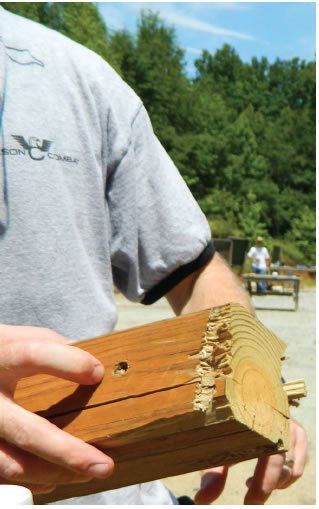
An important consideration in home defense is the prospect of the penetration of a wall by an errant projectile. The primary objective in a defensive situation is to destroy tissue that is vital to the adversary’s mobility. Only when an object or projectile strikes vital neural pathways (brain, spine, some nerve groups) or major blood pipelines (heart, lungs, some arteries and veins) that cause rapid blood loss will the pressurized system of the human body shut down. The primary responsibility of the home defender is to strike the target. Letting go with a round when you do not have a reasonable expectation of hitting the target isn’t a responsible action. Still, being human, we may miss the target, so it’s wise to know what a projectile (bullet, slug, or shot) may do when it connects with common building materials. Also, besides being responsible for every round we shoot, one of the raters in this test pointed out that the defensive shooter may also like to know what he can expect of materials that might hide or protect him if he or a loved on is under fire from an intruder.

To find out how handgun projectiles reacted to impacts on various materials, we first fabricated wall segments with commonly found wallboard and pine boards, then fired a few hundred rounds of ammunition to destroy the structures. At the end, we came up with common-sense recommendations that can solve the problem of overpenetrating handgun bullets that might be used in home defense. Remember, these tests cannot be compared to the FBI test program. The FBI was looking for penetration. That agency needed loads that would reasonably be expected to penetrate light cover and still strike a heavy blow. We were looking for handgun loads that don’t meet the well-known FBI penetration criteria.
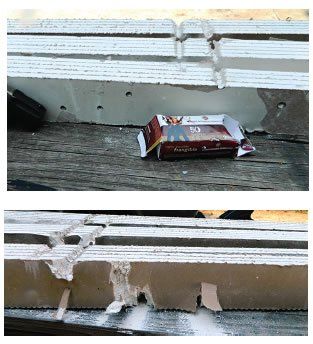
The Home Materials Tested
Wallboard
It should be no surprise that bullets, slugs, and buckshot go through wallboard — it’s just paper and clay. Other generic names are plasterboard and gypsum board. Common product names are Sheetrock and Gyproc. As one of the raters noted, there is no magic bullet that will not penetrate this material in the home and relieve you of the responsibility of aiming straight. We used half-inch-thick wallboard arranged in sections five sheets deep. There was a 1-inch gap between each set of wallboard stacks. Total penetration depth was measured for each round of loads.
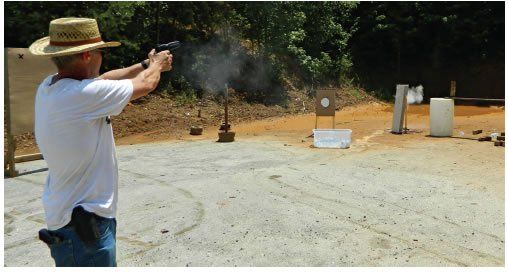
Pine Boards
These were once a universal testing medium, and they only measured penetration. One rater noted that the studs in a wall will be facing rather than length wise. The 4-by-4 posts were spaced 1 inch apart to allow dust and shavings to fall away from the projectile. One of the raters noted that all boards are not the same and that a quarter-sawed board would be denser and tougher. Besides gauging their effectiveness as a barrier in walls, our pine-board penetration results can also stand in for how bullets would do on solid-wood doors, but not lightweight interior hollow-core doors.
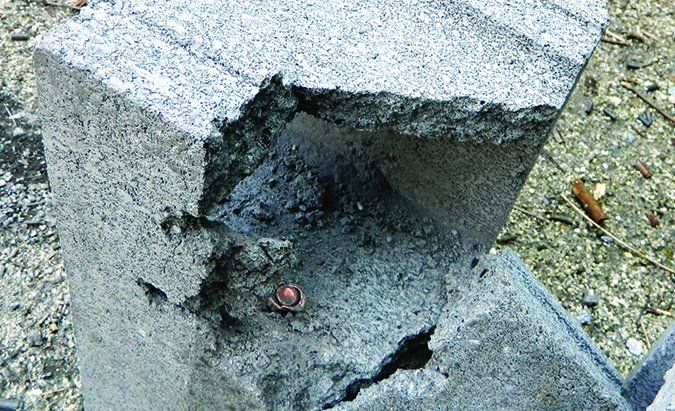
Overpenetration
The problem of overpenetration of bullets in the home or apartment has been discussed many times. The fear of a bullet carrying far past the area of a gun battle is real. Wounds received by innocent persons who happen to be in the wrong place at the wrong time are not uncommon. However, most of these occur in the open or on the street and are a result of missed shots, rather than overpenetration. Also, the great majority of gunshots are the result of criminals shooting victims and other criminals, rather than honest citizens protecting themselves. So, incidents involving homeowners firing through walls and a bullet exiting the home and causing damage, injury, or death are rare. The same is true for injuries caused inside the home. We believe this is because the vast majority of armed citizens are mature, conscientious individuals. Just the same, tragedies do occur, and we decided more than three years ago that the subject was a fertile field for examination.
We looked at the whole picture and tested ammunition from several angles. We tested common personal defense ammunition that we had given good ratings to in the past and learned how they might fare in penetration testing against home materials. We went far past the usual water testing, since ballistic water testing wasn’t applicable to most of what we were doing. We constructed targets using typical home materials and commonly used homebuilding parameters. At this point, allow us to re-emphasize that carefully placing a bullet in an assailant allows the projectile to expand properly — and there will be no overpenetration problem. Working on marksmanship skills is the soundest advice we can give.
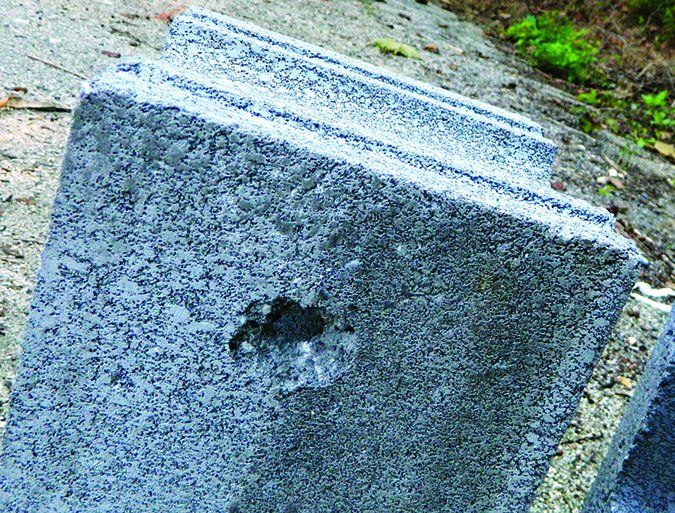
Beyond Marksmanship
Next, knowing the distance between one occupied structure and the next nearest one is helpful, because distance robs errant shots of power and trajectory, because we usually fire at an angled attitude, slightly up or slightly down and seldom perpendicular to the target. Thus, chances are the bullet will come to rest in something before it reaches an occupied home. The bullet may strike the roof, or it may dig into the floor. Or you may have a long hallway with a brick wall at the end to stop or slow a bullet. A studio apartment with thin walls is another matter.
Also, it’s important to realize how ridiculous cinema depictions of gun-battle participants using a chair or mattress for cover really are. Bullets zip right through these constructs. Some furniture may be heavy enough to turn a bullet, and the pine-board results are a good way to estimate those effects without having to shoot up the walnut dining-room table.
As for the difficulty of creating realistic test media, we noted that every test program we read in the popular press was inconsistent, with every author having a different idea of how to gauge the risks of overpenetration. As an example, one of the considerations never mentioned in the popular press is the existence of firewalls between walls in apartment complexes. Building and structural firewalls in North America are usually made of concrete, concrete blocks, or reinforced concrete. These structures are very good at stopping or slowing down bullets.
Pistol-Cartridge Penetration Results
| LOAD | VELOCITY | WALLBOARD PENETRATION | PINE BOARD PENETRATION | RATING |
| 22 LR CCI Stinger 32 gr. HP | 1150 fps | 8 in. | 2 in. | A |
| 22 LR Winchester 37 gr. HP | 988 fps | 10 in. | 2 in. | B |
| 22 LR Winchester 40 gr. M-22 LRN | 939 fps | 9 in. | 2 in. | B |
| 22 LR Wolf 22 LR 40 gr. LRN | 905 fps | 8 in. | 2 in. | A |
| 22 Magnum CCI 40-gr. FMJ | 1079 fps | 12 in. | 6 in. | C |
| 22 Magnum Hornady 45 gr. FTX | 1090 fps | 12 in. | 5 in. | C |
| 32 ACP Fiocchi 60 gr. JHP | 1101 fps | 11 in. | 5 in. | C |
| 32 ACP Fiocchi 71 FMJ | 1078 fps10 | 10 in. | 6 in. | C |
| 380 ACP Hornady 90 gr. FTX | 890 fps | 6 in. | 6 in. | A |
| 380 ACP Fiocchi 95 gr. FMJ | 909 fps | 8 in. | 7 in. | A |
| 38 Special Glaser Safety Slug Blue 80 gr. | 1110 fps | 5 in. | 4 in. | A |
| 38 Special Glaser Safety Slug Blue 80 gr.* | 1190 fps | 6 in. | 4 in. | A |
| 38 Special Remington 110 gr. JHP | 882 fps | 7 in. | 8 in. | B |
| 38 Special Winchester 158 gr. RNL | 707 fps | 6 in. | 6 in. | A |
| 38 Special Winchester 158 gr. LSWCHP +P | 830 fps | 10 in. | 9 in. | B |
| 9mm Luger Dynamic Research Tech. 85 gr. JHP | 1145 fps | 10 in. | 8 in. | A |
| 9mm Luger Fiocchi 115 gr. FMJ | 1121 fps | 12 in. | 9 in. | C |
| 9mm Luger Buffalo Bore 115 gr. JHP +P | 1300 fps | 10 in. | 8 in. | A |
| 9mm Luger Buffalo Bore 115 gr. JHP +P+ | 1383 fps | 12 in. | 12 in. | C |
| 9mm Luger Fiocchi 124 gr. Extrema JHP | 1107 fps | 10 in. | 9 in. | A |
| 9mm Luger Federal 147 gr. Hydra Shock | 1010 fps | 12 in. | 9 in. | B |
| 357 Magnum Cor-Bon 100 gr. Pow’RBall | 1462 fps | 6 in. | 6 in. | A |
| 357 Magnum Winchester 110 gr. JHP | 1262 fps | 11 in. | 7 in. | B |
| 357 Magnum Remington 125 gr. Golden Saber | 1220 fps | 12 in. | 9 in. | C |
| 357 Magnum Speer 158 gr. Gold Dot JHP | 1130 fps | 12 in. | 12 in. | C |
| 45 ACP Glaser Safety Slug Blue 145 gr. +P | 1311 fps | 6 in. | 4 in. | A |
| 45 ACP Glaser Safety Slug Silver 145 gr. +P | 1350 fps | 7 in. | 4 in. | A |
| 45 ACP Buffalo Bore 160 gr. TAC Low Recoil | 967 fps | 10 in. | 7 in. | B |
| 45 ACP Winchester 230 gr. FMJ | 790 fps | 12 in. | 7 in. | B |
| 45 ACP Hornady 230 gr. XTP +P | 909 fps | 12 in. | 12 in. | C |
| Notes: The half-inch-thick wallboard sheets were arranged in blocks of five sheets, separated by a 1-inch gap. The penetration measurement indicates the total depth the bullet reached in wallboard. The pine boards were 4-by-4 posts separated by an inch gap. The 38 Special results were from a revolver with a 2-inch barrel. *The 38 Special results for the second Glaser Safety Slug were fired from a 4-inch barrel. Among the 45 ACP loads, it’s worth noting the Glaser Silver penetrated 10 inches into water. The Glaser Blue 45 ACP +P penetrated 6 inches into water. Abbreviations: HP = hollow point. LRN = lead round nose. FMJ = full metal jacket. JHP = jacketed hollow point. LSWCHP = lead semi-wadcutter hollow point gas check. Ratings in this table are as follows: A = Ideal for the task, with perhaps less penetration than we like but a good compromise. B = A good defense load with more penetration, but still a reasonable choice. C = Too much penetration. | ||||
Pistol Cartridge Notes
Based on our results in this test, we would advise against using round-nose lead or full-metal-jacketed bullets for home defense, if overpenetration is a worry. RNLs and FMJs are effective in the big bores, but the JHPs are is more effective and ricochet is less of a concern. We noticed that RNL bullets sometimes bounced when fired into hard wood. Avoid these bullet designs except for cheap practice.
One point we want to advise you to consider is the choice of bonded bullets. As an example, a wide-mouth hollow point such as the 115-grain JHP used in Buffalo Bore’s +P 9mm load breaks up rather quickly when fired against cinder block and doesn’t penetrate as much in wood as the slightly different Buffalo Bore +P+ load. The +P+ load uses a bonded bullet design, which stays together, as is the intent. Regarding bonded-core bullets then, we need to carefully appraise our choices. For home defense, do we really need a bullet with high penetration against intruders behind wallboard? Generally speaking, what we found was that bullets on the short end in water testing are the least offensive in home penetration. It is clear than the bonded bullets are designed for penetration of sheet metal and window glass and perform as designed. Whether this is desirable is up to the homeowner.
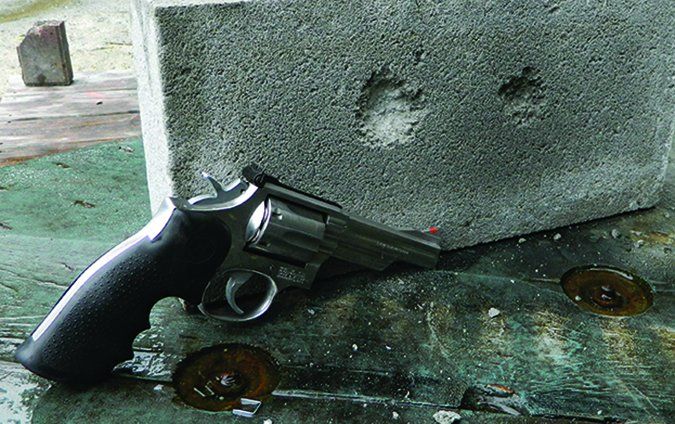
We were also curious about how tougher materials, such as cinder blocks, would defeat bullet passage.These are most often found in a single layer attached to the outside wall of a frame building. Then wall studs, plywood, and insulation form the interior walls. We shot the blocks stacked in groups of four or more. Another consideration is that when the bricks are in sections, mortar holds them together, and the support of the structure keeps them resilient. We also shot some exterior facing bricks, but didn’t record penetration data for either of these because it wasn’t measurable like the wallboard and pine boards were. However, we did collect our visual impressions of what various projectiles did to bricks.
The calibers below 38 Special only made small pock marks in the bricks. Beginning with the 38s, we saw damage. The 9mm and 45 ACP damaged bricks, but hardly enough to go through. After two to four shots, the bricks cracked. A single 357 Magnum took a large chunk out of a brick and often broke it. We found that one to two rounds in the same spot often broke the brick up and crumbled it.
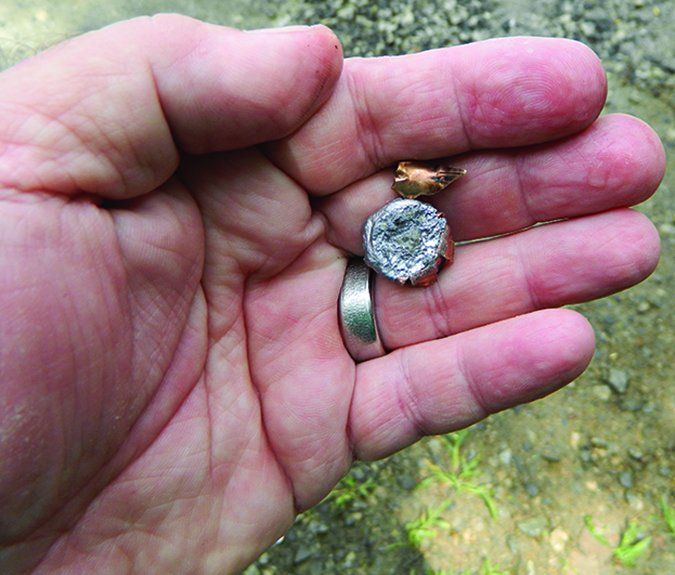
In the case of cinder blocks, the 45 ACP JHPs just made a pock mark and only part of the bullet penetrated on the first shot. The fast-stepping 9mms were much the same. The 357 Magnum 110-grain loads did no more. The Remington 125-grain Golden Saber 357 Magnum struck the block three or four times without great effect, but it did well in previous water testing. The 158-grain Speer JHP 357 Magnum load made a large cavity in the block with the first shot and an opening into the hollow between the two sides of the block with the second shot, and sometimes with the first shot. The third shot with the Speer busted the block. This Magnum is just too much with heavyweight loads. The Winchester 230-grain FMJ 45 ACP also broke the blocks up with very few shots.
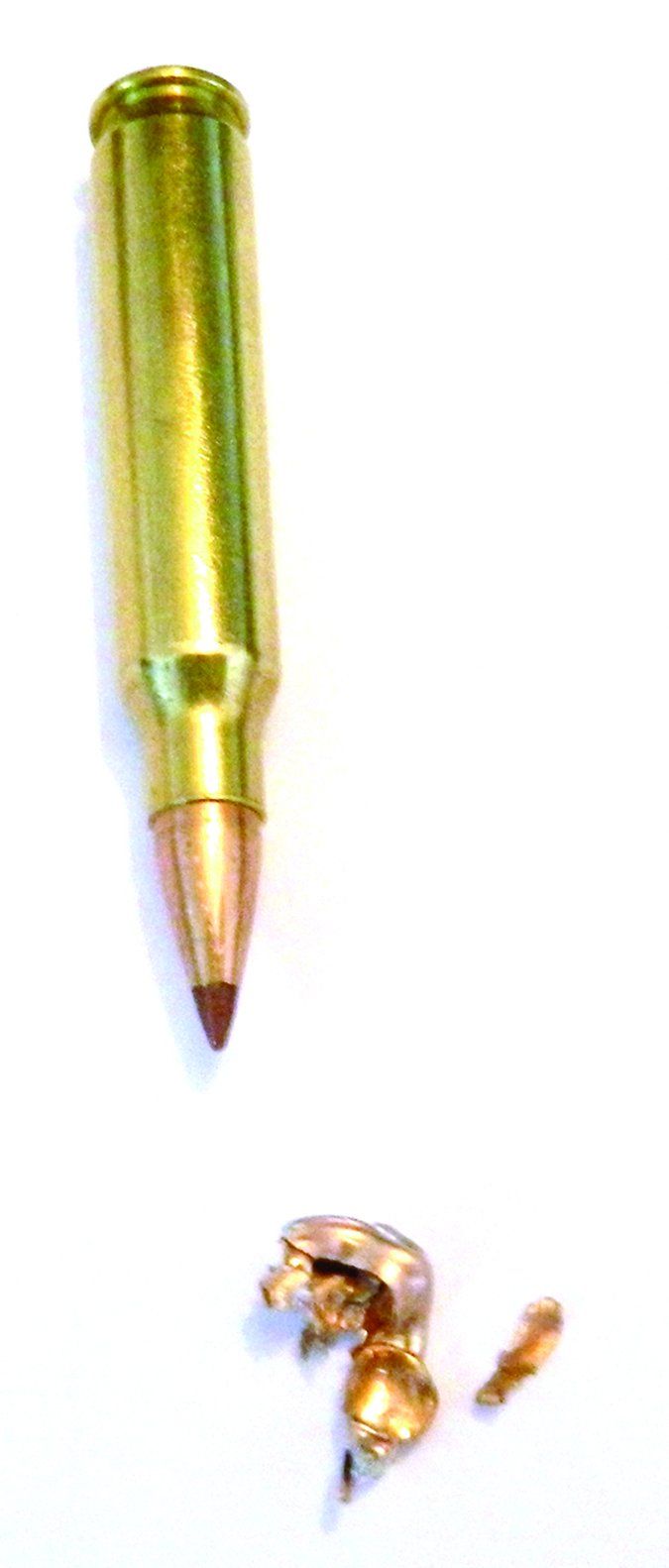
Rifle & Shotgun Side Testing
While we had the building materials out, we also fired a few shotgun and rifle loads to see how they compared to the handgun loads most folks would likely choose for home defense. Also, as we noted in the article about lightweight AR-15s for home defense elsewhere in this issue, it is possible to choose 223 Remington loads that pose less danger of overpenetration than some pistol rounds. If you have the carbine, a light load, and your Wolf Ears ready at home, you are way ahead of the game for self-defense.
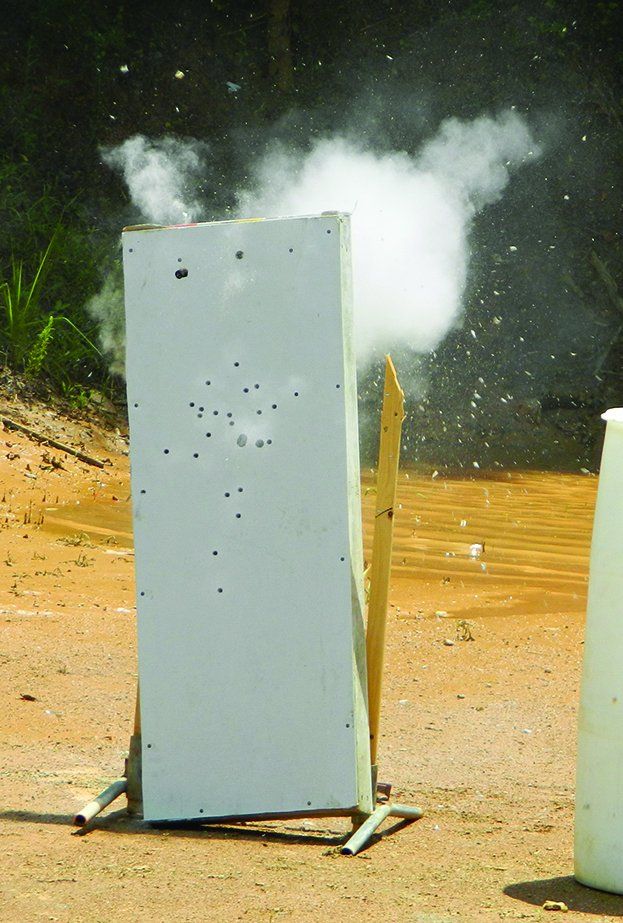
For instance, we fired a Fiocchi 40-grain V-Max round (3600 fps muzzle velocity) and saw it began to fragment in the first section of the wallboard testing. Some pieces made the second section, but none fully penetrated, for a wallboard measurement of 3 inches, or less than any of the handgun rounds. This is a good, safe bullet for interior use. Likewise, a Black Hills 55-grain jacketed soft point 223 round (2840 fps muzzle velocity) only penetrated 6 inches in wallboard, which would put it among the lowest handgun rounds in penetration statistics.
Also, if anyone doubts how awesome the shotgun really is for home defense, some of our results will be eye openers. Wallboard was blasted to pieces by most of the loads tested, with Wolf buckshot and a Wolf slug going too deep, 12 inches. Slugs demolished cinder blocks with a single shot. Winchester Reduced Recoil buckshot was a little more under control, penetrating 10 inches in wallboard.
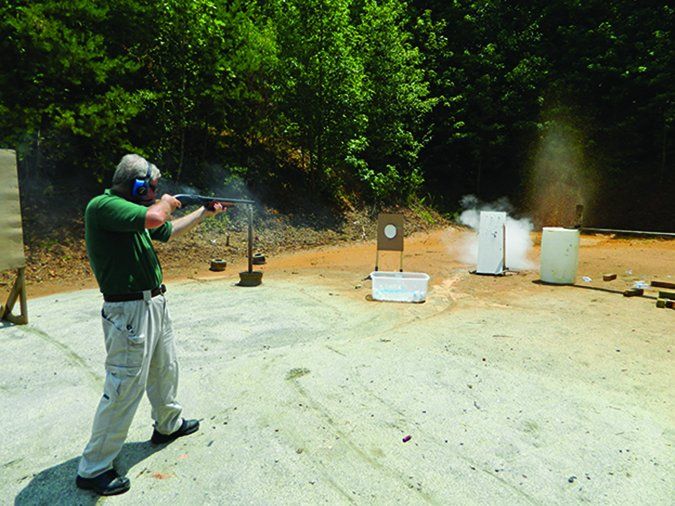
The buckshot loads bounced like crazy in some cases. We stood back at least a 50 feet when testing. Some of the buckshot flattened on cinder blocks and bounced back 10 to 12 feet. This would not be the load of choice in a crowded environment around buildings with cinder-block walls.
We have never tested birdshot for personal defense, so we had to do a few runs with 12-gauge Winchester 7 shot on the water jugs first. This load has widely been recommended for home defense, but in water testing, we saw only 4 to 6 inches of penetration with only one or two pellets exiting the first water jug. Perhaps the common wisdom foresaw how 7 shot performed in wallboard — it only penetrated 2 inches.
Our Team Said
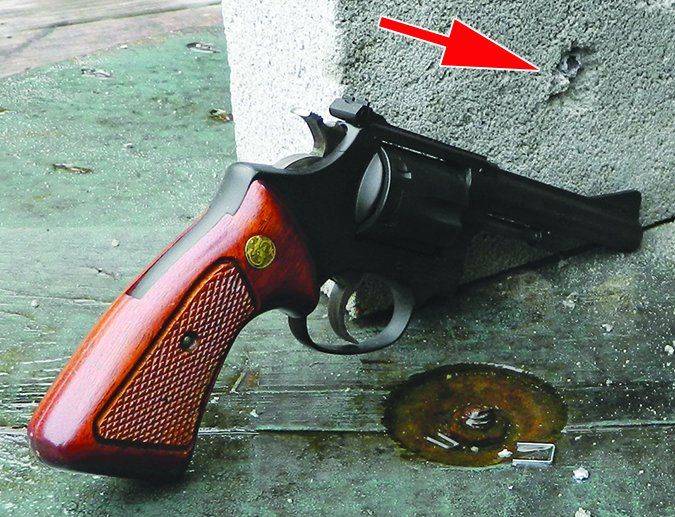
Most of the handgun loads proved capable of penetrating several house walls, as noted in the chart above. Since we’ve all been conditioned to think of penetration as the do-all and be-all of bullet performance, it’s hard to think backwards when penetration must be limited.
Among the 22 LR rounds, we don’t recommend any for home self defense. But if your pistol of choice happens to be a 22 and you want to reduce your risk of overpenetration, we’d pick the CCI Stinger 32-grain hollow point.
A better choice for a home-defense cartridge might be either of the 380 ACPs, the Hornady 90-gr. FTX and Fiocchi 95-gr. FMJ.
There are good selections from the 38 Specials. The Glaser Safety Slug in 80-grain weight offered plenty of velocity but not as much penetration. The Winchester 158-grain lead roundnose is a similar performer in a more traditional form.
The DRT 85-grain would likely be our first pick from the 9mm Lugers, but the Buffalo Bore 115-grain JHP and Fiocchi 124-grain Extrema JHP would be good choices as well.
If you shoot the big 357 Magnum wheelgun, your lowest-penetration choice would be the Cor-Bon 100-grain Pow’RBall.
Among the 45 ACPs, the Glaser Safety Slugs stand out.
Written and photographed by R.K. Campbell, using evaluations from Gun Tests team testers.


























In a self defense situation, let’s say between a Police Officer, and another person, would a 45 hollowpoint round ricochet off of the police officer’s badge at point blank range? No more than 5 feet apart, max, would it even be possible? wouldn’t it just push the badge through a person’s body??
20 gauge shotgun lighter recoil than 12 ga.
20 gauge better target re-acquisition
20 gauge shotgun penetration almost same as 12 ga.
#1 buckshot as much power and penetration as #00, less over-penetration. Also more pieces of #1 shot per shell and a wider spread than #00, so better chance of hit.
#0 buckshot and #2 buckshot worth trying